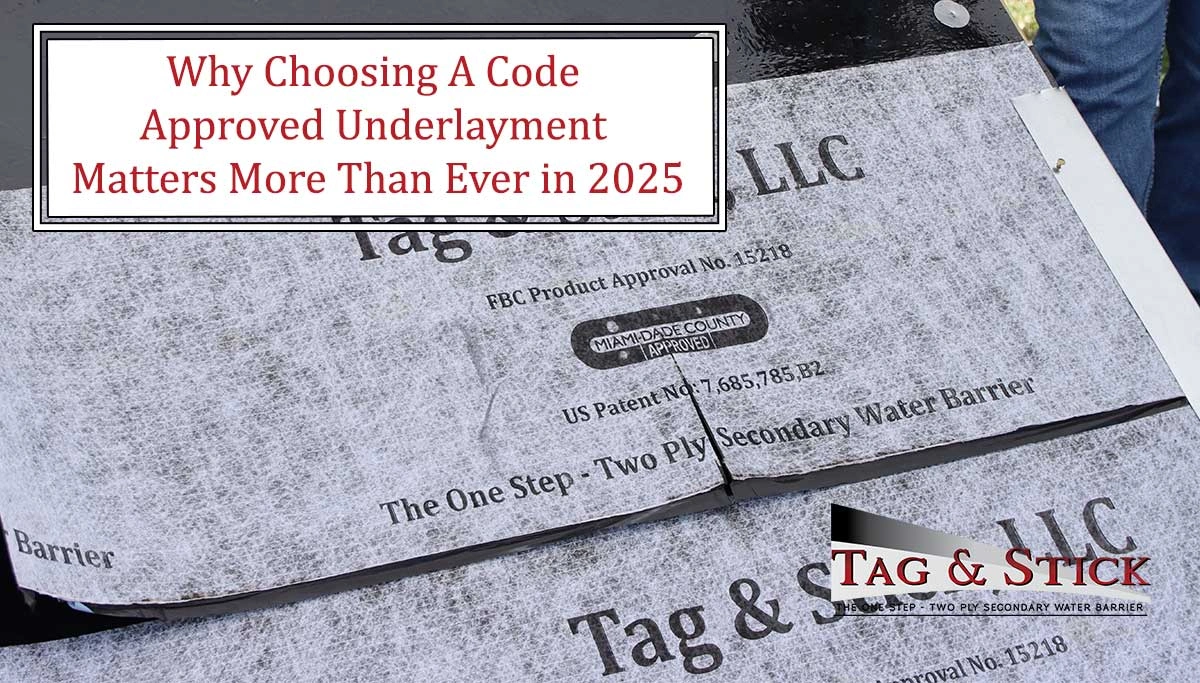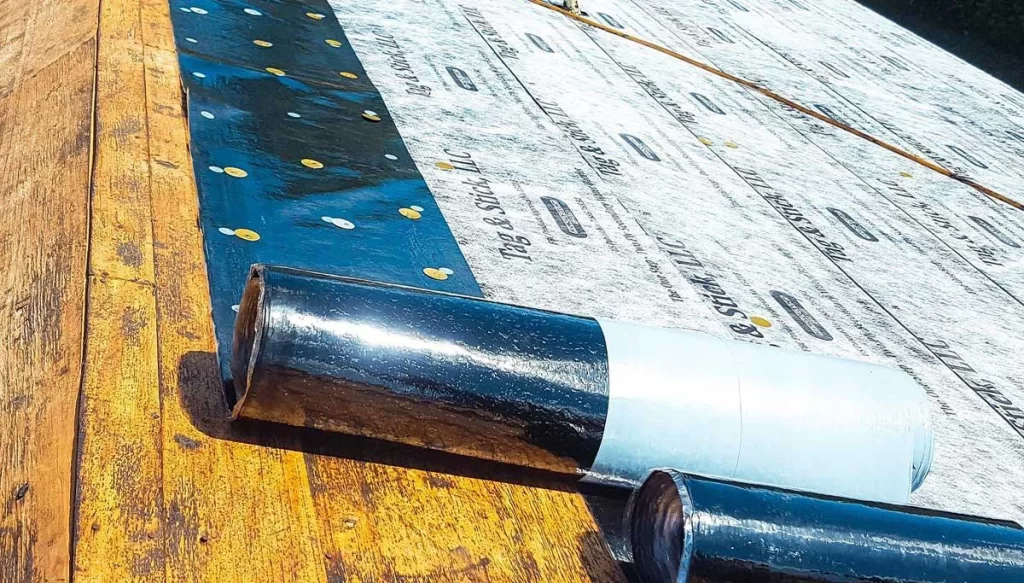Why Choosing A Code Approved Underlayment Matters More Than Ever In 2025

- What Is Code-Approved Underlayment & Why Does It Matter?
- Evolving Building Codes: What’s New in 2025?
- Improved Structural Integrity
- Weather-Resistant Barriers & Climate Trends
- The Cost Of Non-Compliance: Fines, Delays, & Liability
- How to Identify & Select Code-Approved Underlayment
- Why Builders, Inspectors, & Homeowners All Prefer Code Approved Products
- Code-Approved Underlayment In South Florida
Superior roofing underlayment systems are designed to withstand extreme weather conditions. With South Florida’s scorching sun, high humidity, and annual hurricane season, the Florida Building Code (FBC) is continuously being updated to help protect your home. With ongoing climate changes and building code adjustments, it’s paramount to choose a code-approved roofing underlayment in 2025.
Let’s take a look at the code-approved underlayment trends and why Tag & Stick offers the best protection.
What Is Code-Approved Underlayment & Why Does It Matter?

Code-approved underlayment has undergone a series of tests designed to ensure it meets the strictest performance and safety standards. The Florida Building Code, now in its 7th edition, lays out the various performance and safety standards required for roofing underlayment, with particular focus on heavy wind loads and rainfall requirements.
This means that code-approved products are engineered to offer excellent wind uplift resistance, a watertight barrier, and additional UV protection. By investing in a code-approved underlayment, you have peace of mind that your roof will stand up against the sometimes harsh coastal Florida elements and protect your home for years to come.
Evolving Building Codes: What’s New in 2025?
The Florida building code is updated every three years, with the latest publication introducing three noteworthy updates, all of which carry implications for roofing underlayment.
Energy Efficiency
The latest Florida Building Code publication brings in higher insulation standards for roofs to help reduce energy costs by conserving energy. This goes along with better sealing techniques to minimize air leaks.
High-Wind Construction
Roofing systems now require more robust attachment systems that can better withstand hurricane-strength winds. Roofs will also need to be better reinforced.
Improved Structural Integrity
Finally, the Florida Building Code mitigates against potential damage that natural disasters such as hurricanes can cause. This is ensured through more stringent requirements on roofing materials, with a strong focus on compliance.
Weather-Resistant Barriers & Climate Trends

South Florida finds itself on the front lines of climate change with rising sea levels, higher temperatures, and more extreme or active hurricane seasons. All of these increase pressure on your underlayment system. This is because roofing underlayment creates a weather-resistant barrier to withstand extreme rain, wind, and heat. It’s an important line of defense and protects water from seeping into your roof deck, leading to rot and structural damage.
Weather-resistant roof underlayment is engineered to withstand severe climate forces and will protect your home in unpredictable weather.
The Cost Of Non-Compliance: Fines, Delays, & Liability
Choosing not to use compliant underlayment materials and installation techniques can leave you with several negative consequences, with the most noticeable being a failed building inspection. On a site visit, building inspectors will be looking for adherence to the latest FBC standards, and if your underlayment isn’t compliant, it could be costly on several fronts. Non-compliance usually leads to failure to obtain proper permits, project delays, revision work, and possible fines. Remember that any delay of roofing work could leave your roof exposed to the elements, increasing the risk of damage to your home.
Another concern is liability risk. If your roof experiences any sort of storm damage, and it’s found that non-compliant materials were used, your insurance claim may be compromised. There could also be the possibility of legal action against your building contractor, which can drag on for months. It’s just not worth cutting corners when it comes to using superior roofing underlayment and installation techniques.
How to Identify & Select Code-Approved Underlayment

A reputable underlayment will contain certification on its web page and on its packaging; be sure to look out for this. It’s also recommended to check if the manufacturer is a member of the Florida Roofing and Sheet Metal Contractors Association (RSA). Or the Roofing Contractors Association of South Florida (RCASF), as this provides increased accountability.
Also, be on the lookout for a Florida Product Approval (FPA) number, which can be verified on the Florida Building Code Services website. And finally, your chosen underlayment should also meet the Dade County uplift requirements.
Another important step is to speak to the building contractor about specific questions when it comes to the underlayment. They should be able to provide you with concise and knowledgeable information about the product they’re using. You may also ask for references from previous underlayment installations to ensure there is a positive track record in place.
Why Builders, Inspectors, & Homeowners All Prefer Code Approved Products

Reputable builders and contractors favor code-approved underlayment because of its high quality. This means that certified underlayment is expected to pass building inspections the first time, which prevents costly delays. Successful installations also improve a contractor’s reputation for delivering a high-quality product and service.
When it comes to building inspectors, code-approved underlayment helps them to do their job effectively and quickly. Inspections are less time-consuming, meaning that your inspectors can move on quickly without having to conduct a complex report or meet correction requirements.
Finally, for you as the homeowner, a code-approved underlayment provides the peace of mind that your roof has been constructed to the highest standards, providing added protection to your home. You also won’t need to worry about your roof, and code-approved materials offer greater longevity. In the unlikely event of an insurance claim, you can rest easy knowing that there won’t be any comeback on code compliance issues and concerns.
Code-Approved Underlayment In South Florida
Tag & Stick offers the best in underlayment technology and quality assurance. As a member of both the FRSA and RCASF, Tag & Stick’s industry-leading certifications mean that it meets the Dade County uplift requirements as well as the latest Florida building code requirements.
With over 25 years of experience, Tag & Stick offers a strong two-ply application system, providing superior strength and longevity. The combination of mechanical and adhesive technology means our underlayment offers the best performance and safety in the industry. In 2025, choosing a certified, high-performance roof underlayment is the best decision you can make to protect your home.